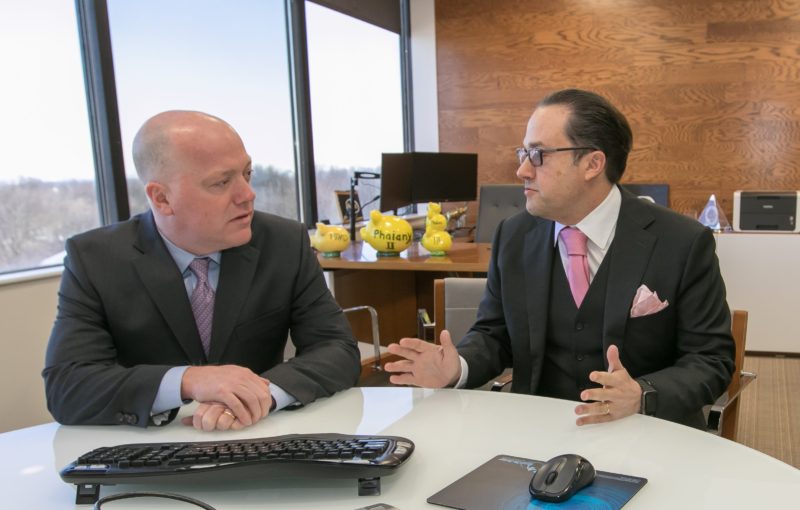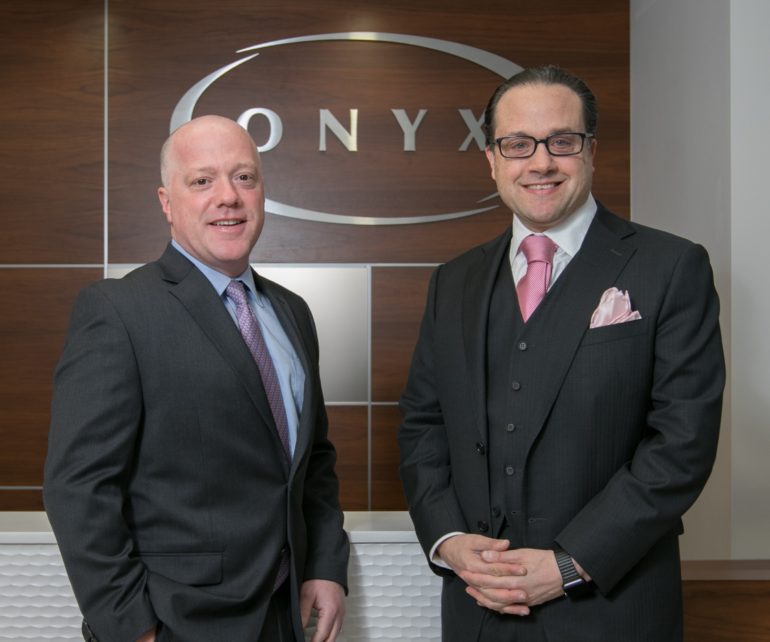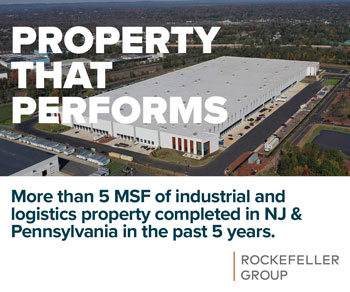John Saraceno Jr. (left) and Jonathan Schultz, co-founders and managing principals of Onyx Equities LLC, have helped grow the company into one of the state’s top private value-add investment firms in New Jersey since its founding in 2004. — Photo by Mary Iuvone for Real Estate NJ
By Joshua Burd
Nearly a decade later, John Saraceno still calls it “one of the best trades we ever made.”
But even that might be an understatement.
It was mid-2007 when Onyx Equities LLC, the real estate investment firm founded by Saraceno and Jonathan Schultz, inked the sale of a seven-story, 260,000-square-foot office building off Interstate 80 in Rockaway. The firm and its investors had acquired the property for $22 million only two years earlier — but were now selling it for more than $55 million.
Not only was it a financial windfall for Onyx and its partners. It was validation for a three-year-old firm that was executing its first fund and preparing to raise a second.
Perhaps more importantly, it was proof that Saraceno and Schultz could recognize when it was time to sell. And it turned out to be especially prudent when the financial crisis struck only months later.
“I know it’s what saved us in our first fund,” Saraceno said. “There was no brilliance on any of our parts, none of us anticipated the depths of the recession we were going into, but we were 100 percent focused on the fact that we wanted to make our investors money. So as soon as a deal was profitable and we knew we could market it at more money and meet the threshold that we said we could do, we liquidated it.”
The mantra continues to drive Onyx today as it prepares to raise its fourth discretionary investment fund later this year, a vehicle that’s expected to reach $100 million. But it’s just one piece of the story for the Woodbridge-based firm — now one of the state’s foremost private, value-add investors.
Along with having acquired more than $2 billion worth of property in the region since 2004, Onyx continues to make headlines in both office leasing and capital markets.
Case in point: It completed one of the state’s largest office leases of 2016, a 305,000-square-foot deal with pharmaceutical giant Daiichi Sankyo, at a repositioned building in Basking Ridge that it owns with Rubenstein Partners LP. Three months later, the joint venture reaped $101 million when it sold a newly renovated, 313,000-square-foot office tower in Jersey City, nearly double the price they paid to take control of the property in 2013.
But as both Schultz and Saraceno will tell you, building the firm has been about more than making good deals.

Consider that Onyx went nearly four years without buying a new property, from late 2007 to 2011, as its principals realized it was time to ride out the storm. It was during that time that they used their existing platform to launch a real estate owned and receivership services business, which now manages distressed assets across 10 states.
“The key to our success is everybody sitting here around us,” Schultz said during a recent interview with some of the firm’s senior executives. “And you need to make everyone feel and know that you can survive good and bad times and that people can progress at where they work.
“Otherwise, why would they stay? And I feel fortunate that we’ve been able to provide that and sort of have a way to tackle markets when they don’t look like you can tackle them.”
Not to mention the firm’s willingness to do things a little differently, take a risk that others won’t take and perhaps spend a little more in order to achieve an outsized result.
It’s all part of a formula that helped Onyx come of age during the real estate downturn and thrive in the years that followed. And the firm is now poised to continue that growth, with plans to stay aggressive in the office sector as it grows its footprint in other asset classes.
For a firm that was founded in 2004, Onyx is rooted in a friendship that began a decade earlier. Schultz said he and Saraceno “just clicked” after first doing business in 1994, when he was president of The Schultz Organization and the latter was a founding member of Ivy Equities.
Ultimately, the pair “helped mentor each other back and forth for years and years.”
Schultz had done some investing by the early 2000s, but said he was ready to move from being a broker and service provider to a full-fledged owner and investor, adding that he “wanted to partner with someone who could take both me and whoever that was to the next level with our talents.”
That made it a natural decision to go into business with Saraceno in 2004.
“What I love about our partnership is that we’re friends who respect each other, and we both do different things well to complement each other,” Schultz said. He added that it’s “not always so easy” when two strongminded people are leading the same firm, “but we’ve figured out how to do that and because of it, one plus one equals 10.”

Saraceno echoed that belief, noting that both men came from sectors that provided the type of “entrepreneurial, organic experience” needed to go into business together.
And while Onyx has come to prove itself as a creative, risk-taking investor, the firm took a comparatively less risky approach after raising its first fund of $25 million in 2005. Specifically, Saraceno said the firm’s earliest ventures involved limited equity in order to reduce its downside risk, but still had the potential for a high return.
That included the likes of Rockaway 80 Corporate Center, where Onyx inked a handful of new leases and upgraded the lobby before selling the building in 2007 with 80 percent occupancy. With that deal and others, it was a case of trying to “not think you’re smarter than what the market’s going to provide to you.”
The strategy paid off when the economy came crashing down just three years into the life of the firm.
“We knew we were late cycle,” Saraceno said. “We didn’t know how late we were and we didn’t know it was going to be as bad as it ended up becoming, but we knew it was late because you could just feel it in the world that we were in.”
Onyx managed to divest about 40 percent of its real estate under the first fund before the downturn began, he said, noting that he and Schultz “fought like hell” to ensure that the platform produced a return for its investors. That meant buying back debt in some cases or simply convincing their partners to stay patient.
“When it gets bad there’s not enough life preservers and boats for everybody,” Saraceno said. “So you’re fighting for yours and we did, and we were able to do it in a way that every deal that we did, less one, made every single investor money.”
Onyx raised $42 million for its second fund in late 2007, but Saraceno and Schultz realized it was time to pump the brakes. The company told its investors — a mix of high net worth individuals, friends and family and other private capital sources — that “it’s over for a little while” and refrained from any acquisitions until 2011. Onyx told its investors that it wouldn’t collect an asset management fee in the meantime and gave them the option of pulling out their money, Saraceno said, but not a single investor walked away.
Staying patient and watching the market unfold would eventually allow the firm to “(shift) materially to a much more value-oriented purchase, opportunistic model” of buying debt and distressed properties, Saraceno said. He added that “when we decided to go up the risk spectrum, part of that … was buying really bad physical assets in good locations and then attempting to convert them to something that is a physical A class asset, or as close to it as you could possibly get it within the limitations the building may provide to you.”
For those properties, the firm recognized that “the dirt that’s underneath that building is in a real market with real dynamics, real liquidity and real access to capital.”

Onyx has since carried that model through to its third fund of $51 million, which it raised in 2013. And assets such as 211 Mount Airy Road, the Basking Ridge building that attracted Daiichi Sankyo, have validated the strategy after the firm and its partners spent more than $10 million to overhaul the building’s exterior, lobby and amenities. In doing so, Onyx has tapped into what has become a long-term flight to quality in New Jersey’s office market.
Stephen Sullivan, the firm’s chief investment officer, said “if there are operators and developers actually willing to take that bet, it’s proven that … there is absolutely tenants in the marketplace who want that Class A product. And we had to make that bet.”
The value of making that bet became much clearer after Onyx began the repositioning project.
“Companies are more apt to move today because of the change in technology and workplace and how labor has evolved,” Schultz said. “In the old days, John and I would fight over a renewal and … you thought you had a lot of deals on the table, but at the end of the day you were just being negotiated with.”
But because attracting the best labor is everything to a business today, he said, “I think, with having an empty canvas and being in real value creation and knowing the tenants want to create that is a plus in our business plan.”
Executing on that plan has meant building a team that could implement the strategy in a way that matches up with the space that was promised in the first place.
“There’s a lot of people that put the easel in the lobby with the idea that1 ‘We’re going to go and improve that asset,’ and that easel sits there for about three or four years and nothing ever happens,” Saraceno said. “I think the thing that has helped us over time is that when Jon and I went to do something, and Stephen actually implemented the purchase, we never didn’t do it. We did it every single time.”
There’s no doubting that projects such as 211 Mount Airy Road and 30 Montgomery, the firm’s recently sold, 313,000-square-foot office tower in Jersey City, have raised its profile in recent years. But Onyx might not have ever had those opportunities if its principals didn’t recognize the need to pivot as the recession set in.
RELATED: Managing the journey at 30 Montgomery
Saraceno recalls 2008 when he “(sat) there watching CNBC all night long to the point where I’d fall asleep on my couch, just wondering when it was going to stop.” He and Schultz came to realize that, while they couldn’t make any new investments for the time being, they had the early makings of a valuable, talented commercial real estate team that they needed to leverage.
With Schultz’s “experiences on the third-party side and on the brokerage side,” the firm met with banks and offered its services. In 2008, Onyx launched a receivership and REO services division that quickly racked up commercial and residential properties around the tristate region. After starting with one building, the platform has since grown to comprise more than 50 million square feet in distressed assets in 10 states. It not only helped sustain Onyx during the industry’s lean years, but allowed it to add employees in a time when others were cutting back. Today, the firm has more than 100 employees, from investment to construction to project management.
“We have a real service organization, and in the times when we couldn’t invest, we were able to survive and thrive through being a real service organization,” Schultz said, later adding: “And it keeps us so sharp that, even in our investments, if you look at our track record, we’ve done really well in good and bad markets. That’s not easy to say.”
Going forward, he said, it’s also important for Onyx to “be creative enough to go out of our comfort zone to get involved in things that will catapult us and keep us thriving until the next reinvention comes or the next market comes.”
Onyx is now preparing to launch its fourth fund later this year. Some industry experts are keeping a close eye on the horizon with the belief that the market is in fact due for a slowdown, and even the firm’s leadership concedes that there is some uncertainty in the years ahead.
But Onyx executives have a plan that they believe will help them maintain their success and drive new growth: Continue to make acquisitions in the best locations and implement the types of improvements that will push the property to the top of its class, knowing that selling at the right time will remain an important part of the business model.
By contrast, Sullivan said the firm in prior years may have purchased what would qualify as “B- and B minus-type of assets that we were only going to bring up to a level of B plus.”
“I think, in this particular environment, it’s really important that we stick to our roots … (and) invest in A locations and properties that — once we’re finished renovating them and getting to an A asset class — there’s absolutely an institutional exit,” Sullivan said. “I think that is probably first and foremost.”
Diversifying the company’s portfolio is also critical.
Sullivan, who joined Onyx in 2011, said the firm will look to reshape its portfolio to include more multifamily and industrial property, noting that “there is lot of capital in the market today” that is chasing those asset classes. He also said “we’re going to be more of a retail player,” a shift that began around 2013 with the purchase of shopping centers in Livingston and Plainsboro.
The firm’s experience at those properties has led to similar acquisitions in Hazlet and Philadelphia, Sullivan said. But he noted that “the basic thesis of buying A locations and … making them into A asset classes” will not change as Onyx moves into other sectors.
The firm also will look to expand its geographic footprint, he said, pointing to properties such as 210 West 31st St. in Manhattan, a retail site across the street from Madison Square Garden.
“If we use that strategy correctly, and if the market in two to three years is a down market, there will always be interested equity partners in buying real estate,” Sullivan said, “but they’re always going to be attracted to the A locations rather than a B or a tertiary location. I just don’t see that being part of our business model.”
He added that “we’ve had other opportunities to invest in other areas, but at the end of the day it’s a local business and we absolutely need to have relationships with brokers and we need to be close to our properties.”
“So we’ve always made the decision to just stay within our roots,” Sullivan said. “We can diversify from a property type perspective, but we’re just very focused on New Jersey, Westchester, Long Island and Manhattan to some degree, but it’s just a local business.
“And as we go into fund four and fund five in the future, I don’t see that changing.”










